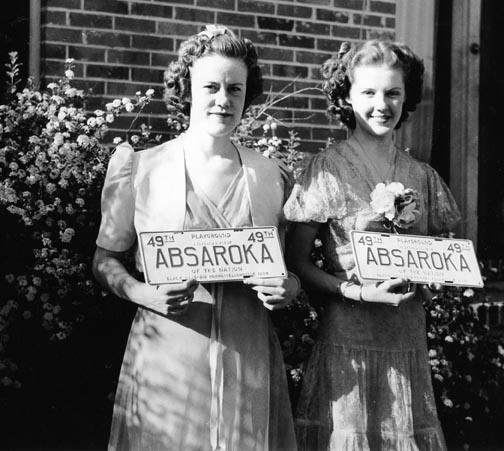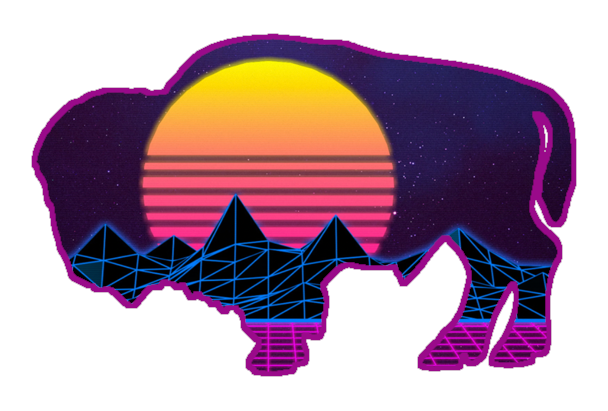If you’re familiar with the TV show Longmire, you might already have heard the name Absaroka. It’s pronounced weird, you would expect it to be said “Ab-sar-oh-kah,” but it’s actually “ab-soar-kah.” The actual word is in the crow tongue and means “Children of the long beaked bird.”

In the Longmire TV world, it’s the name of the fictional county in Wyoming the sheriff works for. Absaroka County is said to be in the same place Johnson County is in our world. The town of Durant, Wyoming is based on Buffalo, and every year they hold “Longmire Days,” to celebrate the books by Craig Johnson and the TV series.
That’s actually how I met Katee Sackoff, who also co-starrred in Longmire! As a Battlestar Gallactica fan– that was twice as exciting.
Back on Absaroka, though. Today we’re not talking about Longmire or the TV series, just the name. Today we’re going to talk about the time parts of Montana, South Dakota and Wyoming were ready to split off and form their own state with blackjack and hookers.
Obviously, this was the time of the great depression and dust bowl. It’s also the period of time in which the most social programs and government plans to keep the general population from ruin and bankruptcy. If you remember our first episode on Nellie Tayloe Ross and the wave of progressivism in the southern part of Wyoming, you can kind of start to see why the ranchers were worried about the New Deal when FDR rolled it out.
– The New Deal was one of the largest governmental undertakings in history. In the most basic terms, it was a conglomeration of a bunch of different public works programs designed to stimulate the economy after the great depression and dust bowl ravaged america’s working class. The whole idea was to get as many people back to work as possible, using public works programs and infrastructure as the means to this end. However, that sounds awfully expensive to the ranchers who are already salty about paying taxes and seeing no improvements to their own way of life–
There are a lot of other reasons why the New Deal was the final straw on the back of Absaroka’s succession, but this was the main crux of the issue.
Ironically it was a New Deal program that even led to Absaroka being remembered in the general consciousness because the government was paying out-of-work writers to write about their communities, and the Absaroka craze hit shortly after the checks went out.
One of the things about that region of the world that will never change– it’s very headstrong, willful, and independent. My own town would have still been in Absaroka, and it makes sense to me. All of the ranchers in the region are very vocal. Driving in this area, you will see dozens of signs proclaiming the positives of eating beef– some of them are spray painted on bales of hay, some of them are made out of welded iron and sitting in the corner of a rancher’s acreage. (I can take videos of both of these places for the video version of this story.)
My own small hometown of Wright would have been a part of the Absaroka proposed state, though my town wasn’t founded until 1984— before that it was just a junction in the middle of nowhere, named Reno. In the 1930s, though, many homesteaders and ranchers lived in the area and the local Thunder Basin Grasslands had just been declared “unfarmable,” by the dust bowl. It now sits as 500,000 acres of public land that leases parts of it to local landowners and fossil fuel companies.
To the north of us in Gillette, the desire for a new state isn’t a new one. A short-lived movement recently tried to get the state of “Campbell,” as a 51st state to secede from the state of Wyoming. It wasn’t a serious attempt, merely a stunt to show the value of the “Energy capital of the world.” Gillette is one of the hubs of fossil fuel extraction.
Moving to the east in Wyoming would be the proposed “Capital of Absaroka,” Sheridan Wyoming. Nestled next to the bighorns, both Sheridan and its close neighbor Buffalo, were part of the Johnson County Cattle war — But that’s gonna be a story for another time.
Sheridan’s proud heritage includes rodeo, indigenous roots, and a populous that embraces its wild west history. Many towns in Wyoming have that wild reputation to fall back on, but Sheridan and Buffalo have the Buffalo Bill Wild West Show credentials to back it up.
With the region’s feelings toward the New Deal and the control the federal government was exerting on local state governments, a man named A.R. Swickard
the street commissioner of Sheridan who appointed himself “governor” and started hearing grievances in the “capital” of Sheridan, Wyoming
For at least a year, there was an excitement among some of the absarokians, excited by the prospect of separating themselves from the people they saw as too progressive to the south. They reveled in the idea of being independent, again, like their ancestors in the johnson county cattle war asserted their power in the region.
So what happened? Why did it fail?
There are photos of a “Miss Absaroka,” from a fun festival atmosphere during the movement. Absaroka licenes plates were made but neve rofficially issued. The whole movement kind of petered out as the progressive programs began benefitting the area close to home. In cody, the Buffalo Bill dam was built- The Devil’s Tower national monument was fortified and given the necessary infrastructure to take visitors. Tourism joined ranching in the wild west as another juggernaut in the local economy.
Break
Remember, this was around the time when the middle class was first beginning to emerge in the United states, so the idea of vacations by car was becoming a huge drive of the small towns along the various highways cross crossing the flyover states as planes began to replace trains as the fasted form of transportation.
It makes sense how such an undertaking could fizzle out when more projects started to be close enough to home.
It’s worth mentioning that just a year after the absaroka fad faded– one of the 3rd largest cities in the state would be set up seemingly overnight between powell and cody– The Heart Mountain Internment Camp. That’s a story for another time, but the gist is that a lot of new and scary things were happening, so the choice to stick with one’s state became a point of pride.
Even today, the idea of absaroka remains as a funfact in history. No one really talks about the possibility of the absarokan state, but the attitude is very much still the same. Headstrong ranchers and independent energy workers, the whole region bleeds with a pride in their work that is hard not to admire.









